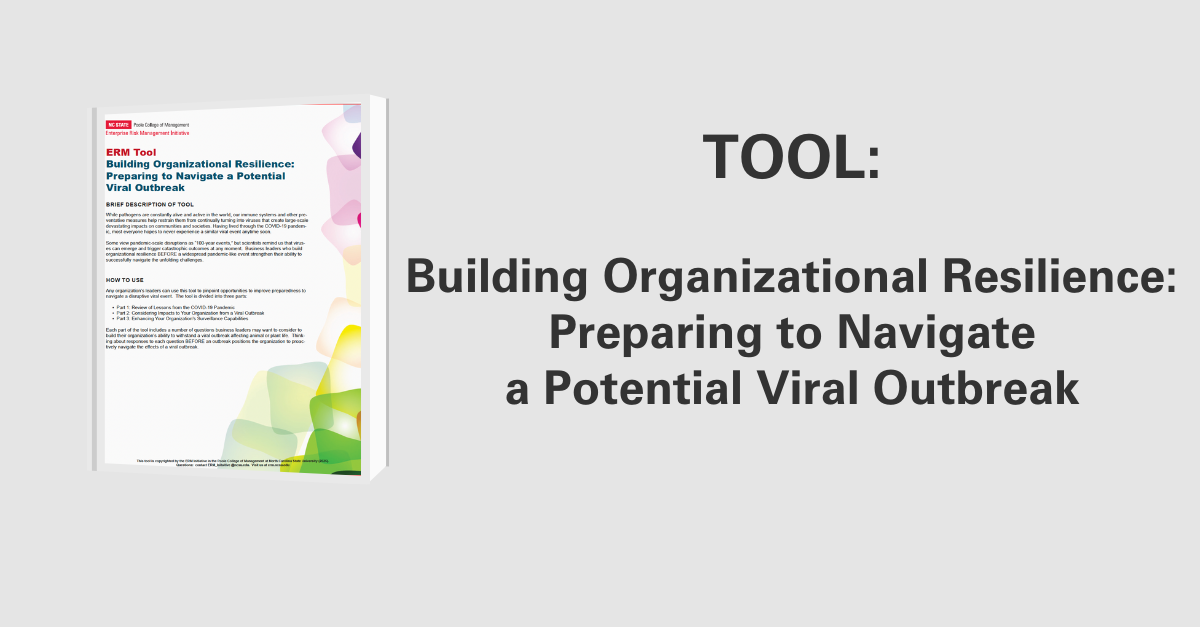Responding to Shifting Global Risk Trends
PricewaterhouseCoopers’s (PwC’s) recent report, Risk in Review: Rethinking risk management for new market realities, sheds insights about a number of conditions affecting global risks and implications for the future. This report is based on the input from over 1,000 executives and risk management leaders from a broad range of companies, including both listed entities and privately owned organizations. The report is organized into three sections: an overview of how 2011 affected the perception of the global marketplace; an examination of regional risks companies should be aware of; and an examination of risk management approaches that can help companies better cope with these risks.
Impact of Risks on the Global Marketplace and How to Think About Risk
Global Complexity
The report discusses the concept of coping with global complexity that is being impacted by the world economy going through structural change and linkages being created by globalization. Components of risks triggered by emerging global supply networks, technologies, and mutating geopolitical borders and how they impact other external risks are not always easy to understand and evaluate. The PwC survey revealed that US CEO’s are slightly less optimistic than they were in 2011, and 80% of CEOs globally are concerned about uncertain or volatile economic growth.
Rising Risk Awareness
The report noted that the majority of surveyed executives believe that risks are increasing, although better education and faster education have heightened awareness. In 2011 executives saw that macroeconomic and financial volatility would continue to dominate the corporate risk agenda.
Focus on External Events
The report highlights that in 2011 risk management leaders began shifting their focus from managing internal risks to planning internal responses to external events. Roughly two-thirds of executives surveyed see the unpredictability of external events as a source of growing risk. As a result, adaptability of the organization is critical so companies can prepare for major changes in the business that may be needed in response to external developments.
Top-down Risk Management
The report noted that in 2011 a growing number of organizations shifted their risk management orientation from bottom-up to top-down, calling for more senior management and board involvement. According to Jason Pett, a partner in PwC’s US Risk Assurance practice and the firm’s US Internal Audit Services leader, the challenge is to move from a reactive risk management philosophy to a proactive one that anticipates coming risks.
Shift to Strategic Risk Perspective
This concept deals with the shift from an operational to a strategic risk perspective, as well as the elevation of the chief risk officer role. The report stated that a growing number of organizations took steps in 2011 to integrate risk management systems across corporate departments and functions.
Overall, some examples of key risks executives identified for 2012 were: economic uncertainty, greater regulation, intensifying competition, and financial volatility.
Top Regional Risks That Face Companies
Emerging Asia
The report noted that the Asia region’s recent economic performance and future growth prospects still look noticeably brighter than those of Europe and the United States, despite a deceleration in growth rates from last year. However, it ranks third among respondents in terms of risk over the next 18 months. In addition, a weaker growth forecast for emerging Asia in 2012 may take an additional toll on the Eurozone economy.
Eurozone
The report noted that tighter lending conditions have begun to have a further dampening effect on the already sluggish economy. The largest single risk to global financial stability is the prospect of the Eurozone’s breakup or the exit of one or more of its members.
Central and Eastern Europe
Central and Eastern Europe is expected to feel the spillover effects of the euro crisis, particularly in the banking sector. However, surveyed organizations have a relatively nonthreatening view of the risks to their businesses posed by events in this region, with 35% of participating executives considering these countries high risk.
Middle East and North Africa
According to the report, political unrest in several Middle East and North Africa countries in 2011 steered in an era of unprecedented political, economic, and social change. The result has been sharp reductions in economic growth in many of the region’s countries. Over three-fourths of respondents consider risks to their business in the Middle East and North Africa region to be very high.
Sub Saharan Africa
While this region has undergone a significant turnaround in the past decade, the respondents view deficiencies in commercial operating environments, including conflicts and rising threats from terrorist activity, as considerable threats.
Latin America
According to the report, survey results showed that just over half of surveyed companies consider the region to be high risk, a lower proportion than for other emerging market regions. According to Oxford Economics, the biggest risks in store for the Latin America region overall in 2012 are the further deterioration of the Eurozone debt crisis and the possibility of a China hard landing.
United States
The report noted that consumer confidence in the United States has been on an upswing in recent months. Additionally, only one quarter of surveyed firms see the United States as posing high risks. However, any further deterioration in global financial conditions due to the Eurozone crisis continues to pose a considerable risk, as do rising tensions with Iran.
Risk Management Approaches and Tools
The report discussed several approaches that companies can adopt to cope with the new realities. Increasing communications and data sharing will be a top priority for companies in 2012. Improving quality and reporting of data is something 57% of surveyed respondents are focusing on. Better forecasting and scenario analysis is another priority. The report noted that companies are turning to more sophisticated tools such as early warning systems and contingency plans as they reconfigure their approaches to managing risk. The creation of the Chief Risk Officer position is increasing across several sectors, as awareness has grown that the risk function’s effectiveness could be compromised if it is not well integrated into both overall strategy and the operations and decision-making processes. Also, companies continue to integrate risk management into decision-making processes relating to “traditional” functions such as strategic planning, investment/divestment, budgeting/forecasting, and performance measures. Strengthening IT defenses is important, as data privacy and security was pointed out as an area that is likely to receive increased investment during 2012 and beyond. Finally, greater board involvement is necessary as this year will see further shifts to a top-down approach.
Original Article: “Risk in Review: Rethinking risk management for new market realities”, PWC, 2011
- Types:


